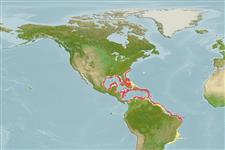>
Eupercaria/misc (Various families in series Eupercaria) >
Lutjanidae (Snappers) > Etelinae
Etymology: Etelis: Greek, etelis, -idos = a fish, perhaps the fish Sparus aurata (Ref. 45335).
More on author: Valenciennes.
Environment: milieu / climate zone / depth range / distribution range
ນິເວດວິທະຍາ
ສັດທະເລ ກ່ຽວກັບ(ຢູ່)ຊັ້ນນ້ຳໃນທະເລທີ່ເໜີອພື້ນດິນ; ລະດັບຄວາມເລິກ 100 - 450 m (Ref. 9626). Deep-water; 37°N - 25°S, 8°E - 32°W
Western Atlantic: Bermuda and North Carolina, USA, Gulf of Mexico southward through the Caribbean to Sau Paulo, Brazil (Ref. 55), including the Fernando do Noronha and Atol das Rocas Islands (Ref. 113956).
Length at first maturity / ຂະໜາດ / ນ້ຳໜັກ / Age
Maturity: Lm 31.0, range 35 - ? cm
Max length : 100.0 cm TL ຕົວຜູ້/ບໍ່ມີເພດ; (Ref. 9626); common length : 64.0 cm TL ຕົວຜູ້/ບໍ່ມີເພດ; (Ref. 6912); ນ້ຳໜັກສູງສຸດທີ່ເຄຍຈັດພີມມາ: 6.3 kg (Ref. 56081)
ຄີ (ໜາມ)ແຂງຢູ່ຫຼັງປາ (ທັງໝົດ) : 10; ຄີຫຼັງຂອງປາ (ຄີອ່ອນ) (ທັງໝົດ) : 11; ຄີ(ໜາມ) ແຂງຢູ່ຄີກົ້ນປາ
ກຸ່ມປາກະດູກແຂງ
ຄວາມຖີ່ຂອງກຸ່ມຖ່າຍທອດພັນ
ປາທີ່ມີການເຄື່ອນຍ້າຍຈາກທະເລໄປຫານ້ຳຈືດ ແລະນ້ຳຈືດຫາທະເລ
ປາທີ່ມີການເຄື່ອນຍ້າຍຈາກທະເລແລະໄປໄຂ່ຢູ່ນ້ຳຈືດ
ຄີກົ້ນຂອງປາ
ສັດທີ່ມີກະດູກສັນຫັຼງ
ການຖ່າຍທອດທາງກຳມະພັນຈາກພໍ່ແມ່ຫາລູກ: 3; ຄີກົ້ນຂອງປາ: 8. Head small; eye large; snout short. Maxilla covered with small scales; lower jaw slightly projecting. Dorsal and anal fin bases without scales; caudal fin deeply forked. Scale rows on the back running parallel with the lateral line. Back and upper sides deep pink to red; lower sides and belly pink; fins pink except the spinous portion of the dorsal fin; entire caudal fin brilliant red.
Adults inhabit rocky bottoms and feeds mainly on small fishes and squids. They are abundant near oceanic islands (Ref. 9626). Small individuals are taken as by-catch in trawl fisheries (Ref. 5217). Marketed mostly fresh, sometimes frozen. Flesh of good quality.
Life cycle and mating behavior
Maturities | ການສືບພັນ | Spawnings | Egg(s) | Fecundities | ຕົວອ່ອນ
Allen, G.R., 1985. FAO Species Catalogue. Vol. 6. Snappers of the world. An annotated and illustrated catalogue of lutjanid species known to date. FAO Fish. Synop. 125(6):208 p. Rome: FAO. (Ref. 55)
IUCN Red List Status (Ref. 130435)
Threat to humans
Harmless
Human uses
ການປະມົງ: ເປັນສີນຄ້າ
ເຄື່ອງມື
Special reports
Download XML
ແຫຼ່ງອີນເຕີເນັດ
Estimates based on models
Preferred temperature (Ref.
123201): 13.3 - 22.7, mean 18.3 °C (based on 73 cells).
Phylogenetic diversity index (Ref.
82804): PD
50 = 0.5625 [Uniqueness, from 0.5 = low to 2.0 = high].
Bayesian length-weight: a=0.01698 (0.01384 - 0.02083), b=2.93 (2.87 - 2.99), in cm total length, based on LWR estimates for this species (Ref.
93245).
ຊັ້ນເຂດຮ້ອນ (Ref.
69278): 4.2 ±0.57 se; based on food items.
Generation time: 3.8 ( na - na) years. Estimated as median ln(3)/K based on 2
growth studies.
ຄວາມຢືດຢຸ່ນ (Ref.
120179): ຂະໜາດກາງ, ປະຊາກອນຕຳ່ສຸດທີ່ໃຊ້ເວລາສອງເທົ່າ 1.4 - 4.4 ປີ (K=0.29-0.61).
Prior r = 0.24, 95% CL = 0.16 - 0.36, Based on 1 data-limited stock assessment.
Fishing Vulnerability (Ref.
59153): Low to moderate vulnerability (34 of 100).
Nutrients (Ref.
124155): Calcium = 20.6 [8.4, 56.2] mg/100g; Iron = 0.501 [0.218, 1.134] mg/100g; Protein = 18.2 [16.1, 20.1] %; Omega3 = 0.387 [0.185, 0.742] g/100g; Selenium = 21.5 [8.7, 53.3] μg/100g; VitaminA = 7.31 [1.36, 42.54] μg/100g; Zinc = 0.252 [0.166, 0.397] mg/100g (wet weight);
